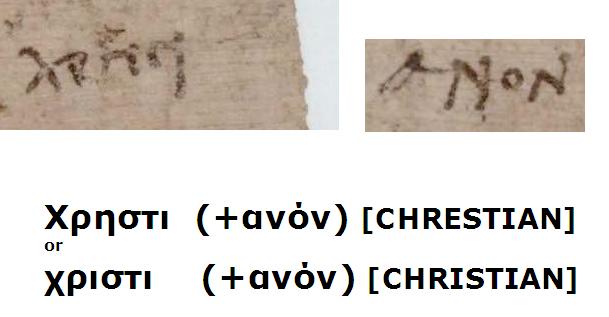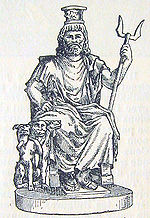
 |
Freethought & Rationalism ArchiveThe archives are read only. |
|
|
#1 | |
|
Contributor
Join Date: Mar 2006
Location: Falls Creek, Oz.
Posts: 11,192
|
Papyrus Oxyrhynchus 3035
Quote:
Image: P. Oxy. XLII 3035 (© Copyright the Egypt Exploration Society).  ZOOM View 
|
|
|
|
|
|
#2 |
|
Veteran Member
Join Date: Jul 2008
Location: Location: eastern North America
Posts: 1,468
|
Hi Pete,
Thanks for introducing this papyrus, in the context of re-examining the chrestiani. It does look, at least to me, as though the text displays eta, rather than iota. There have been some interesting posts in earlier threads, if I am not mistaken, on this topic. Seems to me, maybe in error, that Sheshbazzar had a very useful post on Chrestiani, a while back, maybe two years ago, or so..... ? Is it possible that, back then, just as there were certain conventions (nomina sacra, etc), and certain methods of penmanship that seem a bit awkward today, that the scribe wrote an eta, thinking of iota? Is it possible that eta is a variant reading, often substituted for iota, in other words, as well? I am thinking, as I write this, of my forthcoming message to Ben regarding papyrus POxy 3.405, because the first letter, Beta, looks, to my untrained eye, like Kappa, instead. Maybe there were wide variations in penmanship? Is it possible that this bit was tossed onto the rubbish heap because of the spelling error? Maybe the scribe, working for the police, issuing this warrant, was a native Copt speaker, whose understanding of Greek would have been less than perfect: look at the letter rho, following the chi, for example, not really well done, right? Or, alternatively, maybe in Coptic, a Hamitic language, the vowels are somewhat less important than they are in the IndoEuropean languages, like Greek, so, for that scribe, there was no distinction between eta and iota, in terms of the sound of the word, so he/she simply transcribed a verbal instruction according to what he/she heard from his/her superior. avi |
|
|
|
|
#3 |
|
Veteran Member
Join Date: Jun 2010
Location: seattle, wa
Posts: 9,337
|
An inscription at Deir Ali, Syria written five years after the edict of toleration (318 CE) references 'Jesus Chrestos.' The title Chrestos IMO comes from the identification of Jesus among the heretics as the angel of the presence who wrestled with Jacob at Peniel and from which the nation of Israel derived its name (chrestos = yashar in the LXX and yashar is usually identified by early sources as the source of the name Israel).
|
|
|
|
|
#4 |
|
Contributor
Join Date: Jun 2000
Location: Los Angeles area
Posts: 40,549
|
By the third century, eta and iota would have been pronounced the same in Koine Greek, as they are in modern Greek.
You will find many previous threads in this forum on Christos vs. Chrestus and Christian vs. Chrestian. It's hard to draw any particular conclusion from this papyrus. The anomaly that sticks out for me is that this Christian or Chrestian is called "Petosarapin of Horus" invoking two different Egyptian pagan gods (the prefix pete- refers to "given by" Sarapis being the Greek spelling of Serapis.) |
|
|
|
|
#5 | |
|
Veteran Member
Join Date: Jul 2008
Location: Location: eastern North America
Posts: 1,468
|
Here's a rather
interesting blog on the topic: Quote:
Yup, learn something new, every day. Thanks again Pete. avi |
|
|
|
|
|
#6 | ||
|
Contributor
Join Date: Mar 2006
Location: Falls Creek, Oz.
Posts: 11,192
|
Quote:
Earlier UseageSo perhaps "chrestian" is some form of title like "The Good Person" or "The Excellent One" or even just "The Good" or something like that. I think it must have been reasonably common. Some reports identify it to be associated with as the bowl found following excavation of the underwater ruins of Alexandria's ancient great harbor. (No wonder Alexandria's the place to go) POxy 3.405 Quote:
|
||
|
|
|
|
#7 | |
|
Contributor
Join Date: Mar 2006
Location: Falls Creek, Oz.
Posts: 11,192
|
Quote:
|
|
|
|
|
|
#8 | |
|
Contributor
Join Date: Mar 2006
Location: Falls Creek, Oz.
Posts: 11,192
|
Quote:
 I too think its hard to draw any particular conclusion from POxy 3035. |
|
|
|
|
|
#9 |
|
Veteran Member
Join Date: Jun 2010
Location: seattle, wa
Posts: 9,337
|
mountainman,
The way I see it if you thought Jesus was a man you called him Christos, if you thought he was some supernatural being or God you called him Chrestos. The thing that complicates that neat packaging is that the name Shilo can be argued to be translated by the Gk chrestos (Shilo = 'the right' one). In that case Chrestos could apply to a human being within the Jewish tradition. Nevertheless the types of sects that identified Jesus with Chrestos all seem to emphasize his divine nature. As such I take the LXX's translation of chrestos for yashar as being more important (see the early interest in Jeshurun as related to the name Israel, or Jacob taking his name from an angel named Sariel or Israel, Suriel or the like). |
|
|
|
|
#10 | |
|
Veteran Member
Join Date: Jul 2008
Location: Location: eastern North America
Posts: 1,468
|
Quote:
Matthew 3:16-17 in Codex Sinaiticus, revealing the same writing style, as found in P.Oxy 3.405--i.e. writing "kappa" to represent "beta". link kindly provided by Toto, in which the four fragments of P.Oxy 3.405 are stated as belonging to a roll, but clarified earlier today, by Andrew as likely having once been part of a scroll. Ben's excellent web site, which displays, character by character, a precise transliteration of the main section of text (delimited by the three labels, a, b, f) on the largest of the four fragments. Nota bene, that more than 90% of this fragment, a,b,f, is devoted to quoting a passage from Matthew 3: 16-17, and, so far as I can tell, the assessment, that these four fragments belong to AH by "Irenaeus" is based upon fewer than ten Greek symbols: μη ζητουσιν according to Ben, but, in my post earlier today, at Jay's thread, I have asked for clarification on this point, because I do not see a few of these symbols on the fragment. I wonder if those fewer than ten alphabetical characters are all that we have, as evidence of a "second century" date of authorship? avi |
|
|
|
| Thread Tools | Search this Thread |
|